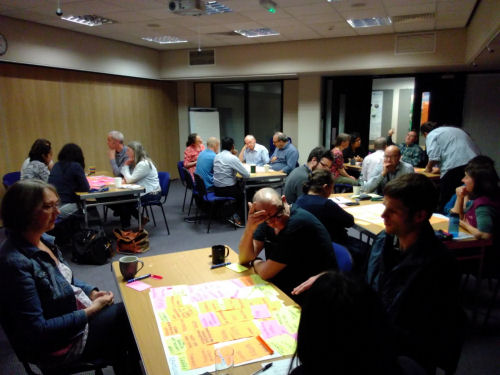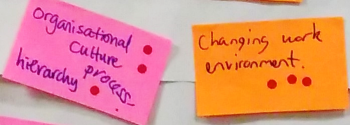Towards an Agile Approach to Sustainability Science

The IT industry has been undergoing a revolution in the way software is developed. The traditional so-called ‘waterfall’ method, in which the customer is only really involved at the beginning and the end of the project, usually ends up several years later with the customer being dissatisfied with the result, costs out of control, and managers and technicians wondering what went wrong. For several years now, the ‘agile’ movement in the software industry has been redefining roles and relationships in software projects, bringing the customer in to the development team, and focusing on practices that support the success of the project.
Agile shifted vocabulary and practice around software development – ‘customers’ become ‘product owners’ who join the development team; ‘plans’ become ‘kanban boards’; ‘team leaders’ are instead ‘scrum masters’ (a very different role); and working solutions, however crude initially, are developed quickly, and co-evolve iteratively and rapidly with requirements. Critically, a culture emerged in which changing requirements are welcomed, even late in development: features the product owner might originally have thought essential are not developed further if they are found not to deliver value; or new features inconceivable at the time the work was commissioned can be introduced.
With the launch of its Corporate Plan in 2016, the third of the three scientific challenges The James Hutton Institute set itself was developing social and technical innovations that support sustainable and resilient communities. Sustainability science has a long history of recognising the value of engaging with stakeholders to achieve results on the ground, using approaches involving buzzwords such as quadruple helix, action research, participatory research, social innovation and transdisciplinarity. However, the ‘publish-or-perish’ mentality in academia can lead to the stakeholders’ needs taking second place to the science. That, and a lack of clarity about what, precisely, constitutes transdisciplinary research, results in stakeholders participating in projects ‘as a favour’ to the academics, rather than benefitting from it as intended. Worse still, technical (as opposed to social) innovations are sometimes developed with ‘imaginary’ end-users in mind, with results that, though scientifically brilliant, may never lead to more sustainable ways of living.
It is arguably much less useful developing solutions for imaginary people in hypothetical futures than it is doing science for real people that supports changes towards mainstream sustainable living now. Just like in the IT projects, as citizens, we know there is a problem that needs to be solved, but we can’t specify exactly what we want, and we expect we will still need interdisciplinary scientific knowledge to help achieve it. Maybe part of the problem is the way we are commissioning, running and assessing science.
In August 2017, scientists at The James Hutton Institute held a workshop to discuss the agile revolution and how it might be applied to the way we do the science needed to address the challenge of living more sustainably and resiliently. We invited Adrian Howard of Quietstars, a leading figure in the Agile community, to give a talk on how agile has revolutionized software development, and run the workshop helping us think about how we could apply agile to the way we do science.

The workshop involved an exercise called ‘culture mapping’, which is aimed at eliciting the organizational culture that might be getting in the way of implementing the changes needed to deliver on our science strategy. In culture mapping, participants are encouraged to look at the outcomes we are delivering and want to deliver, the behaviours we are actually doing that lead to the outcomes that we are delivering or that might lead to the outcomes we want, and the enablers and blockers of those behaviours. We began in small groups, then combined our culture maps by voting on the post-its people had written in each category. For example, the “save the world” post-it, a photo of which is featured at the top of this article, was one of the outcomes, and the two red dots on it show it got two votes.
Since we were particularly interested in overcoming the blockers, we took all those post-its and categorised them according to whether we had full control of them, influence over them, or no control at all. As we discussed them, it was surprising how many things we thought initially we had no control over were really things we could influence. Examples included ‘Changing work environment’ and ‘Organizational culture: process; hierarchy’.

Although at first it might be understandable to assume that both the work environment and organizational culture are outwith our control because they are determined top-down, there are various things we can do about them. If your work environment is not conducive to helping you give your best to save the world, that is something to raise with your line manager or group leader. Even if managers can’t do anything about it, they should at least know, and there are other options that may be open to some of you, such as working in the library or working from home from time to time.
Similarly, although organizational culture is not something you have full control over, it is something you can influence, not least because you are part of it. ‘We want to make a difference’ is one of The James Hutton Institute’s core values. Therefore, in addition to ensuring management at least know about it any issues, it is worth reflecting, as an individual, on how you might be inadvertently contributing to the very culture you find inhibitive. Do you think about who else in the Institute might be affected by actions you undertake and take steps to appropriately involve them? If you manage people, do you just expect them to ‘follow orders’ without discussion? Equally, do your managers need to tell you every last detail of what they want you to do before you are willing to do it?
The workshop highlighted how we have more autonomy than we think we do. That’s an important take-home message, not only for the way we do science, but also for learning to live more sustainably.
